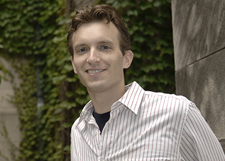A scholarly look at peace on earth
Fulbright winner to study coexistence of Reformation Protestants and Catholics

When it comes to relations between religions, religious violence — still raging in many parts of the world — captures the lion’s share of media attention as well as of historical scholarship. Scott Marr (GRS’07), a new Fulbright scholarship recipient, is interested in illuminating periods when rival religious groups coexisted peacefully. “After reading several studies of religious violence during the Reformation, I began to wonder about the flip side to this situation,” says Marr. “Catholics and Protestants couldn’t kill each other 24/7, so what were their relations like the rest of the time?”
Marr’s Fulbright scholarship will allow him to pursue this question with a year of study in France. Marr will be living in Angers, in the Anjou region, where he will have access to notarial records that chronicle contracts made between people living in the area; by cross-referencing these with church parish records of births, deaths, and marriages he will be able to chart ongoing relations between Protestants and Catholics. Saumur, the town Marr will be focusing on, is known to have had a mixed religious community that got along peacefully during the Reformation while violence was erupting elsewhere. Marr hopes his research may illuminate why.
Marr is one of over 1,200 U.S. citizens who will travel abroad for the 2006–7 academic year through the Fulbright Student Program; the scholarship is given jointly by the U.S. Department of State and the J. William Fulbright Foreign Scholarship Board and is intended to promote mutual understanding between the people of the United States and the rest of the world.
Marr discussed his Fulbright year with BU Today.
What do you plan to do with your year in France?
My dissertation is on religious coexistence in France in the sixteenth and seventeenth centuries, and I’m studying the town of Saumur, a community in the Loire River valley in western France. The town was divided religiously between Catholics and Protestants during this era, and I’m studying how members of the rival faiths got along in their daily lives. In other communities in France, there was sometimes great animosity and violence between Catholics and Protestants. However, at Saumur, they lived together in relative peace. I’m looking at the social and economic relationships that bound Catholics and Protestants at Saumur together and provided a basis for coexistence, even though they remained separated by religious beliefs and practices. The notarial records will show me who was making contracts with who, and the parish records will help document whether they were Catholic or Protestant. It’s by no means an exact science; you can’t be absolute. If you’re honest, you can say you have a strong belief that because someone was baptized Protestant and associated with Protestants, that they were probably Protestant their whole life.
I’ll be living in Angers, France, which is the largest city in the region and where the most important archives for my project are located. I’ll also be visiting archives in Saumur and Nantes. The Fulbright application required me to secure an affiliation with a French university or research center, so I have an affiliation with the History Department at the University of Angers and I’ll be attending some seminars and research discussion groups while I’m there.”
How did you choose Saumur?
Nobody had studied it before. I was talking with my advisor about towns with Catholic and Protestant communities, and Saumur was uncharacteristically far north for a town to have such a visible Protestant community. And they had a strong printing industry there, and a professional academy, so it was a vibrant community.
What are your aims for the project?
To finish it! I want to write a good study that makes a contribution to the field and that other people will want to read. Religious affiliations often create boundaries at the same time that people are linked by community. There are places where different religious groups live side by side, but many where it seems impossible. It seems so strange that it’s so easy sometimes and sometimes so hard. I don’t think I have a solution to offer, but I am raising questions that are driving conflicts today.
What makes your topic timely?
My topic is timely because religious violence is still a persistent phenomenon. Catholics and Protestants in Northern Ireland; Muslims and Hindus in Kashmir; Catholics and Muslims in the Balkans — all these places have experienced the consequences of religious violence. However, like Saumur in the seventeenth century, there is coexistence at some level in each of these areas. I don’t believe that my dissertation is going to solve the problem of why religion sometimes leads to violence, but it does perhaps have resonance to the modern age.